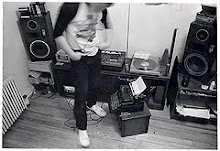 YAMAHA P22
YAMAHA P22
About ten years ago, after we bought a house and had the room for it, my wife and I brought over what was once my childhood piano. I'd been its main champion though childhood, and so I'd convinced my mom to give it to me years earlier.
It was a crappy, impossible to tune and somewhat wobbly Jansen console from the 1960s, seen here in my father's photo. Yes, that's me and my sister smoking something (it was the 60s). Despite its shortcomings, I was fond of the piano. After all, I had it's every crooked harmony burned deep into my auditory cortex.

But we had toddlers and the piano was so wobbly that we soon thought it might fall and kill one of them. After only a short while I lugged it back to my dad's house, where it sits today.
We did think our children should have the chance to take lessons and make some noise and, of course, I liked to play. Somehow we had a bit of money and decided to get a new piano. I couldn't have been more thrilled.
If you've ever done it, you know that buying a piano is not like buying a washing machine or even a Fender Strat. There are few prices clearly advertised anywhere. At least I couldn't seem to dig them up online, and found the dealers didn't like to quote them on the phone either. It seemed a huge industry-wide conspiracy designed to keep me, the buyer, in the dark, even worse than buying a car. This was about ten years ago. Now there are a good number of forums and user discussions where you can get a better idea of what you should be paying.
We'd gotten a notice in the mail about an
amazing program in which universities were getting rid of pianos which had been gently used for only a year or so — at an
incredible discount. Supposedly you got a wonderful deal on a slightly used instrument, and were helping out a school in the process.
Soon we found ourselves on the campus of a well known New Jersey state university looking at a room full of pianos — and getting the hard sell.
Somehow we settled on the
Yamaha U22 Upright. It was cleanly designed, not frilly. It had a solid feeling, a huge warm sound and a beautiful finish. Aside from a tiny scratch that had been touched up very well, the piano was perfect.
I don't remember exact cost, but It was over four thousand dollars. The dealer — and it was a dealer, not the university that was selling these — explained that the piano was sold as "new" because it had never been sold before. It was on loan to the school in some difficult to describe way, but the important fact was that this piano had never registered a sales receipt. This was good for me, he continued. I'd still get all the benefits of the warranty and a "like new" piano for a great price. They wanted to deliver it THAT DAY. We settled on the next.
Once home I went back online and researched that exact model. The Yamaha U22 was described as super sturdy in build, on heavy casters, and designed for and often chosen by schools and rehearsal halls. Ok, satisfying research. Maybe our new piano had survived university use better than most, since it was a model build for that kind of thing. It wasn't a music school, so I doubted it had been played more than a few hours a day, tops. My own kid's school had one. All good, we could pound on this one.
But after some detective work I found document in the public record of a local school district: It was a bid [accepted] for a piano identical to the one I'd bought — for about $1000 less, and that one was new!
I suddenly felt like a sucker. I called the guy who'd sold it to us up and told him I thought I was being over-changed. Was he going to let me out of this deal? No wonder they wanted me to take delivery so soon... before I got wise!
Much to my surprise the guy calmly asked what I wanted to pay, and dramatically lowered our cost. I was calmed, but the experience left a bad taste in mouth.
To drop the price as much as they did, and so quickly, made me realize these guys were making
way too much on these instruments. Essentially the pianos were being sold twice. They probably got that tax break in the school deal, or maybe some kind of slippery lease payment, made their money, then made it again selling to people like me.
In the end the piano did not disappoint. It has held up to my heavy hands. It sounds great, looks great.
The moral of the story? Nothing new: Buyer beware. Especially on a big ticket once in a lifetime purchase like a family piano.





















